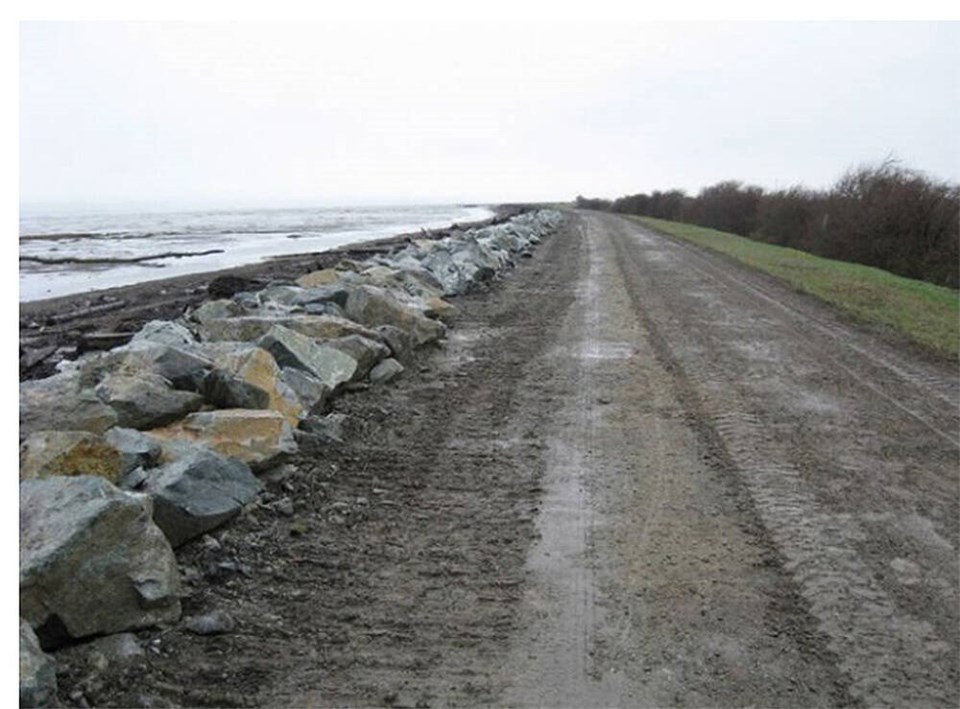A new leadership group will soon be formed to identify flood mitigation priorities and evaluate options to reduce the risk in the region.
A recent Metro Vancouver status report on the Fraser Basin Council’s Lower Mainland Flood Management Strategy Leadership Committee notes the Lower Mainland Flood Management Strategy (LMFMS) initiative, which was completed this year, is a comprehensive multi-year effort aimed at developing a regional strategy to reduce the risks associated with Fraser River and coastal flooding. It’s also to increase the flood resilience of Lower Mainland communities.
The initiative was overseen by the multi-government LMFMS Leadership Committee with secretariat, facilitation and technical support from the Fraser Basin Council (FBC).
The Leadership Committee has focused on completion of the LMFMS initiative through the development of the Pathways to Action for Flood Risk Reduction and Resilience (PTA) report.
With the release of the PTA report in summer of 2023, the work of the Leadership Committee is now complete.
The PTA report is seen as a key document as it reflects the consensus recommendations for action by First Nations, local, provincial and federal government contributors.
One of the key recommendations for early action in the PTA report is the establishment of a new leadership table, comprised of First Nations, local, regional, provincial and federal government representatives, to build on the previous work of the Leadership Committee.
“One of the first areas of focus for the new leadership table is to take immediate steps to assess high priority critical infrastructure and essential services in the Lower Mainland, the most flood-vulnerable region in Canada, working within the broader context and direction of the United Nations Declaration of the Rights of Indigenous People, and related provincial and federal legislation. The assessment will serve to identify mitigation priorities and evaluate options to reduce risk and increase resilience for these priorities,” the report notes.
Meanwhile, as far as ongoing flood risk reduction initiatives in the City of Delta, staff provided an update to the Agricultural and Hunting Regulation Advisory Committee including the city having received a $2 million grant from the provincial government to assist with raising a portion of dike near the Boundary Bay Airport, between 72 and 88 streets. Preparation for the project is to commence soon and the city plans to use fill material obtained from large construction projects in order to reduce dike raising costs.
As far as dike improvements on Westham Island, staff have been granted permission to complete dike maintenance and minor filling on the top of low-lying portions of the dike in the area, which will minimize the risk of over topping during high tides.
Staff noted that that dike maintenance differs from dike raising, which may require seismic analysis.
The city will also continue to work with Inspector of Dikes to find “innovative and cost-effective solutions” for raising the dikes, such as the recently completed Living Dike Pilot Project and upcoming Boundary Bay Dike Construction Fill Pilot Project.
If the pilot projects prove to be a success, there is an opportunity to expand them, according to staff.
During Delta council’s discussion on the province’s British Columbia Flood Strategy Intentions Paper earlier this year, a precursor to an upcoming provincial flood strategy, Engineering Director Steven Lan noted the estimated cost, so far, for 67-kilometres of dike raising and seismic improvements by 2100 is at more than $1.9 billion, with the first phase alone, excluding seismic improvements, tabbed at $350 million.
The city currently has $6.5 billion in private property and public infrastructure protected by Delta’s diking infrastructure, while the estimated damage by a major dike breach is anywhere from $1 billion-to-$3 billion, according to a Delta report, adding about 53 per cent of Delta’s land mass is vulnerable to flooding.
The Fraser Basin Council recommends establishing a long-term funding program to support implementation of the LMFMS, with senior level government financial support clearly needed.




